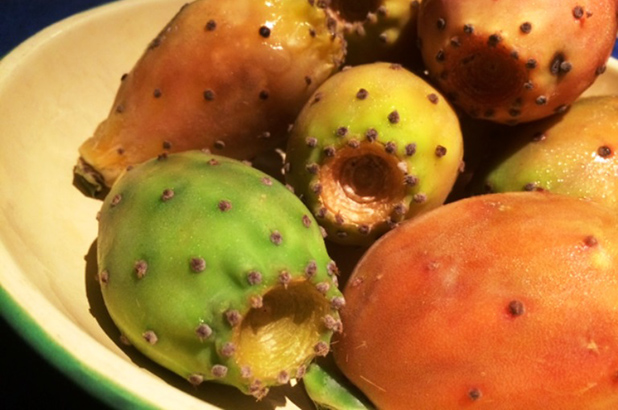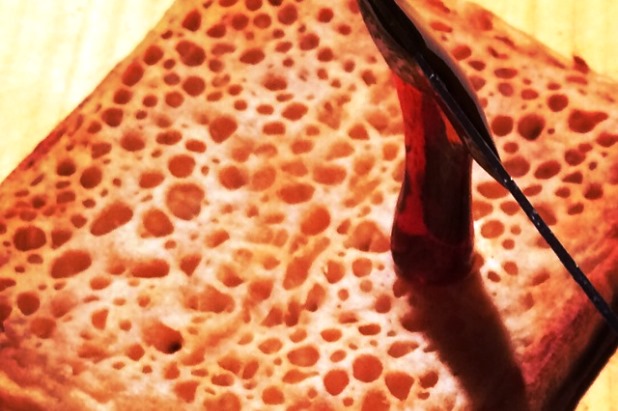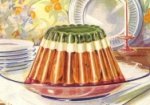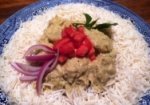The Curator’s recent story, Of palings, palisades and prickly pears, times perfectly with prickly pear fruiting season. Be very careful when harvesting the fruit, to avoid the spiny needles on the plant’s ‘paddles’, which can pierce even the most protective gardening gloves. Their ‘prickle’ comes from the fruit themselves, its minute, seemingly invisible filaments leaving you with a lingering itchy feeling on your skin. Experience has taught me that it’s best to handle them with care – silicone tipped tongs are ideal. Needless to say, I was delighted to find some at my local green grocer’s, so managed to avoid the need to pick my own!
Needley weed
Queensland author Hannah Maclurcan advised in her cookbook:
‘The prickly pear is seldom used, although if properly treated is most delicious; it has the richest colour of any of our native fruits.’
It’s interesting to note that Maclurcan erroneously nominates the prickly pear as a native fruit, indicating their proliferation in the 1880s and 1890s. Her book, Mrs Maclurcan’s cookery book first published in 1894, includes two recipes for prickly pears, both of them jellies – one the bottled preserve type, the other a moulded dessert flavoured with lemons, sugar and sherry, and set with gelatin. She cautions:
‘If required for jam you must be most careful to see that all the prickles are removed, otherwise it may be unpleasant to get one of those nasty little things in your mouth ; for jelly, of course, it has all to be strained, so should you leave a few in it would not be so serious.’
Judging by the prickly feeling still on my hands today after making the jelly preserve this week, the thought of imbibing them is rather horrifying. Hannah’s technique for removing the prickles is novel, but probably effective:
‘Get the prickly pears, rub them in sand or sawdust with your boot or a piece of wood until all the prickles are removed …’
The fruit can vary in colour, from green to pale orange (as shown) and even a deep ruby red, but our local varieties tend to fairly pale skinned. The delicate melon or peach-toned blush hints at its fleshy contents, not unlike a tamarillo or heirloom tomatoes but with larger seeds, reminiscent of ‘ardana’ or dried pomegranate seeds. I tried eating one raw, but found it’s flavour underwhelming and the seeds and pulp a bit like congealed tomato, but I was keen to try a colonial jelly recipe.
PRICKLY PEAR JELLY
1 lb fruit (450g)
1 lb sugar (450g)
Juice of a lemon
Rind of 1/2 a lemon
1/4 pint water (150ml)
MODE: Cut the fruit in half, put it into a large basin, cover it with the sugar, and allow it to stand for a couple of hours, then put it into the preserving pan with the lemon juice, rind and water. Allow it to simmer for four hours or until it jellies, then strain through a towel tied to a chair, or a felt jelly bag. When nearly cold, put into the jars, and when quite cold, fasten it up securely.
Mrs Maclurcan’s cookery book (1903) Rouse Hill House and Farm collection.
I followed Maclurcan’s instructions, and as the ‘pears’ cooked with sugar and lemon juice the colour deepened from a pale honey to a guava pink and eventually a rich amber-rose. The kitchen smelled heavenly! I left the batch to strain through a few layers of muslin overnight. The fruit remains were quite caramelised and quite hard, which seemed promising.
Over cautious
I was concerned that the strained liquid was too thin and wouldn’t set unless refrigerated, a point that wasn’t made clear in the recipe. It occurred to me that it would make an amazing dessert syrup at this point in the process, for pancakes and the like, maple syrup style, but thought I’d stick to the original plan, in the interests of good colonial recipe testing. I gave it another blast of heat, gel testing every few minutes, but my nose soon told me I’d taken it too far, delivering a delicious but slightly burnt, treacle-like aroma and colour. Lo and behold, my test trickle set like sticky toffee in the fridge! I’ve bottled it up anyway, and am waiting for it to cool as I write.
Accidental hero
Well, I definitely overcooked and probably overheated it, but managed to produce a highly delectable treacle-like syrup, which was wonderful on breakfast crumpets, and would make an equally good addition to porridge in winter. It was sweet but not at all sugary, with subtle fruity notes that play on top of palate – vaguely tropical with hints of guava, strawberry and passion fruit.
The verdict
I’m quite delighted with my accidental outcome, but in the interests of good faith, I will just bottle it once drained next time, as Mrs Maclurcan instructed, and use it as a dessert syrup on pancakes and puddings as a point of comparison. It would make an interesting glaze for pork. I’m still at a loss as to how it equates as a ‘jelly’ but perhaps the natural pectin content is lower in the modern crop, or simply a seasonal variance. I guess I could add ‘jamsetta’ as a further experiment … Either way the flavour is quite special, and well worth the effort. Do let us know if you try it yourself, or have your own techniques for Prickly Pears.






